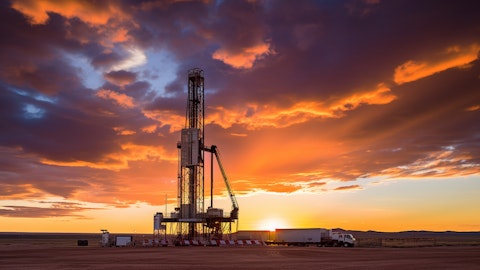James West: Got it. Thanks, Lorenzo.
Lorenzo Simonelli: Thanks, James.
Operator: Thank you. We apologize for the technical difficulties. [Operator Instructions] One moment for our next question. Our next question comes from Neil Mehta with Goldman Sachs. Your line is open. Neil, your line is open. Please ensure you’re not muted. One moment. One moment for our next question. Our next question comes from Scott Gruber with Citigroup. Your line is open.
Scott Gruber: Good morning. I want to ask about the 20% EBITDA margin target for IET. Consensus currently stands at about 16.2% for next year. I realize you restructure the business, but just looking at going from 16% in ’24 to 20% in two years or so, it’s a big jump. Can you just provide some more color on the drivers of margin expansion in the segment and your overall confidence level in achieving the 20% by ’26?
Nancy Buese: Yes, sure. It’s a great question, giving how strong the pipeline is in order since we really published our margin targets last September. I would say the biggest driver is the mix of the mix, and that’s really the headwind, and that’s sort of the variable to our EBITDA target. So while we continue to expand the install base, that’s sort of pushing the services revenue as a percentage of the margin targets. And we’ve said publicly that service is in a much higher margin than the equipment. So when you think about the things we’re doing to drive to that 20% margin, it’s really a continued progress on our cost-out and transformation process at the segment level, thinking how we can be leaner, how we can operate more efficiently.
You’ll also see improvement in the industrial tech margins, and the supply chain and chip shortages really continue to normalize in that space. And then certainly Gas Tech services is slower to ramp in the impact this year of the continued aviation supply chain issues, which we believe will start to abate in 2024. And then the other piece to remember is that we have been absorbing additional R&D costs as we think about the investments we’re making into climate tech for the back half of the decade. So all of those things together with a very strong top-lying growth allow us the past and to see the transparency around how we get to the 20% margin. But we are confident in our ability to attain those margins, and we will continue to work for more, but we definitely see line of sight towards the 20%.
Scott Gruber: Appreciate that. And just as we think about going from ’24 to ’25 to ’26, is it a linear expansion, Nancy, or because of the mixed headwind with all the equipment growth, is the margin expansion a bit more back-weighted with more expansion going from 25 to 26 than what we’ll see from ’24 to ’25?
Nancy Buese: Yes, I think you’ll see a gradual ramp up, but it will be a little bit lumpy, and the part we can’t necessarily predict is the pace of the equipment orders and where the services revenue will pop in. So I would say you’ll continue to see a trajectory up and to the right. It’s hard to say exactly where those bigger gains will occur, but we will continue to provide line of sight of that with our guidance.
Scott Gruber: Okay. Appreciate the color. Thank you.
Operator: Thank you. One moment for our next question. Our next question comes from David Anderson with Barclays. Your line is open.
David Anderson: Great. Thanks, Nancy. I’m just going to stick with you if we could, please. I want to ask you about the backlog conversion on the Gas Tech equipment side. Last quarter, there was a little bit slower. It seems like you righted it this quarter. If I look kind of overall compared to last year, which like conversion will be something like 45% compared to 2022 yearend backlog. Just wondering how we should think about this trending over the next year or two. Are you doing things internally that should speed up backlog conversion? But the other hand, I also think that there’s a mix of orders and how that includes conversion rate might kind of change that a little bit. Can you talk about how you see that progressing?




